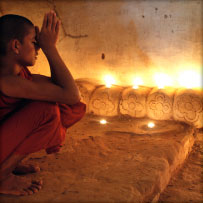Chandragomin
Chandragomin (Skt. Candragomin) was a renowned 7th century CE Indian Buddhist lay master and scholar who dressed in the white robes of the Yogic tradition and mastered the morality of the five precepts.
A famous seventh-century Indian lay practitioner who challenged Chandrakirti to a debate that lasted many years. His writings include Twenty Verses on the Bodhisattva Vows (Skt: Bodhisattvasamvaravimshakah; Tib: jam-chug sem-pä dom pa nyi shu pa) and Letter to a Disciple (Skt: Shisyalekha; Tib: lob-ma-la tring-pä tring-yik).
He was most famous for his debate of Candrakīrti (600–c. 650), (Devanagari: चन्द्रकीर्ति, Tib. Dawa Drakpa) the Arya Tripitaka Master Shramana who was the Khenpo at Nalanda Mahāvihāra Monastery. Their debate was said to have gone on for many years. Chandragomin held the Chittamatra (consciousness-only or Yogachara school) view, and Chandrakirti gave his interpretation of Nāgārjuna's view, eventually creating a new school of Madhyamaka known as Prasangika. This Nalanda tradition school is known as Prāsaṅgika Madhyamaka or rendered in English as the "Consequentialist" or "Dialecticist" school of Nagarjuna view. Chandragomin (seventh century): Wrote Twenty Verses on the Bodhisattva Vows
According to Thrangu Rinpoche, Chandragomin was slow in the debate but always had the right answers because each time a question was posed by Chandrakirti, Chandragomin would insist on giving the answer the next day after praying to Avalokiteshvara who would tell him the right answer.
Major works
- Chadragomin's writings include 'Letter to a Disciple' (published by Dharma Publishing as 'Invitation to Enlightenment')
- Translated from the original Buddhist Hybrid Sanskrit into Tibetan is Chandragomin's 'Shurangama Mantra Sadhana' (Tibetan canon Tengyur Karchag Phangthangma Toh 3096, Toh 593/2/1). It is titled Sarvatathāgataoṣṇīṣaśitātapatrā-nāmāparājitā-mahāpratyangirā-mahāvidyārājñī-nāma-dhāraṇī; Tibetan name is 'phags pa De bshin gshegs pa'i gtsug tor nas byung ba'i gdugs dkar po can gshan gyi mi thub pa phir bzlog pa chen mo mchog tu grub pa shes bya ba'i gzungs.
